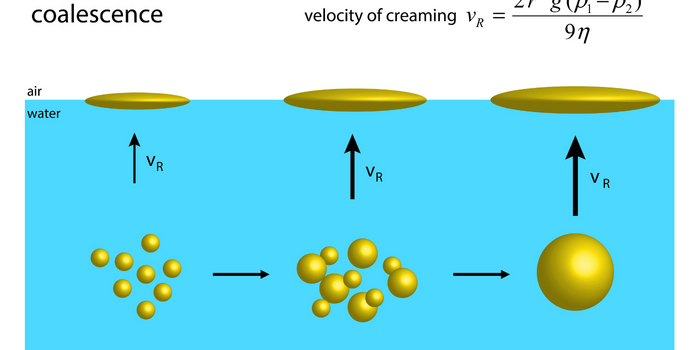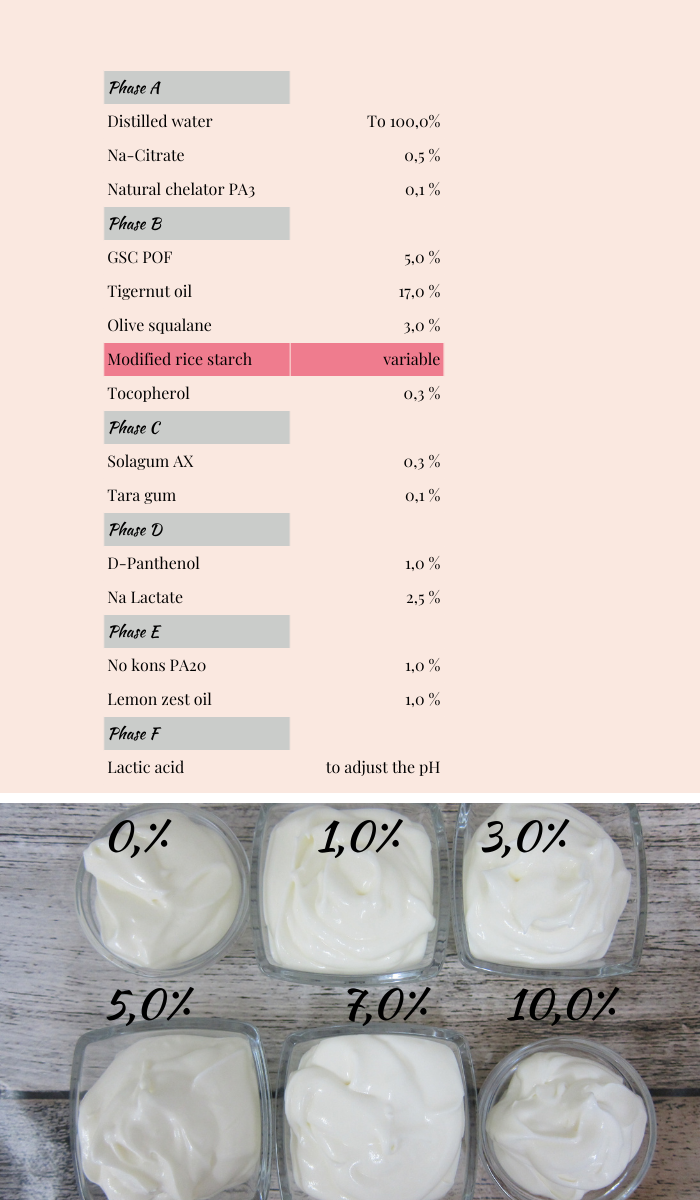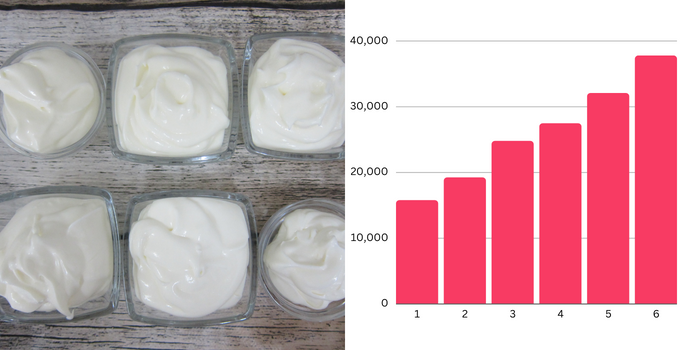
What are basic ingredients of an emulsion?
Well you will need an oil phase, a water phase and a suitable emulsifier to be the match maker between the oil and the water phase. Then you will need emollients and moisturisers, stabilizers and an efficient preservative system. Colour and scent are optional but not necessary. In the "natural" and plant based world you usually rely on the inherent colour of the plant oils and extracts and although a big majority of emulsions contain essential oils or fragrance oils, the number of "fragrance free" products is increasing as well.
Did we forget anything? Yes we did
Texture modifiers are ingredients that are added to the formulation only for the sake of enhancing the texture. They may have an impact on the viscosity, skin feel and stability but their main role is to enhance the texture.
One of these texture modifiers that is being used by us for over 5 years now is the "modified rice starch" which is an anionic starch derived from rice.
We have published several tutorials in the past using this ingredient in emulsions, balms, deodorants and cleansing powders:
Texture modifiers oat silk vs rice starch
Valentine's cranberry body melt
This ingredients imparts a dry touch in balms and butters, absorbs moisture and odour in deodorants and increases the viscosity as well as enhances the stability of emulsions in addition to changing the skin feel from good to ah-mazing.

Emulsions are dynamic systems. This means the particles are always in motion (although you can not seed that with naked eyes). Since they are in motion, they collide together and usually smaller particles attach to each other and create bigger particles. This process is called coalescence and is one of the main reasons for emulsion instability and phase separation. Our main aim as a formulator in creating stable emulsions is to avoid or to reduce the chances of coalescence to keep the emulsion as stable as possible. Adding the anionic rice starch increases the repulsion between the particles. This is one factor contributing to the emulsion stability. The other factor is its impact on the viscosity. As you can see in the above equation the velocity of coalescence is reversely related to the viscosity of the emulsion. The higher the viscosity the lower the rate of the coalescence. This is why creating stable low viscosity emulsions is much more difficult than the medium and high viscosity emulsions and this is why we use gums and other polymers as emulsion stabilizers. Simply by increasing the viscosity of the outer phase, we reduce the rate of coalescence and hence enhance the stability of the emulsion.
Enough of theory
Let us use the rice starch in sample emulsion formulations and show you how it works
1- This is an anionic ingredient. You can use it with anionic and nonionic emulsifiers but not with cationic emulsifiers
2- You need to add this ingredient to the oil phase before heating the oil phase. It doesn't dissolve in the oil. You just need to keep it suspended by stirring
We have used this ingredient up to 5% in emulsion before. This time we went over the edge and added up to 10% starch to the emulsion and the results were mind blowing.
Obviously the viscosity increases with increasing the starch concentration.
We prepared a KISS formulation as always and used our GSC palm oil free (POF) emulsifier. This is itself an anionic emulsifier and since it creates medium viscosity emulsions it is easier to observe and compare the viscosities visually and even without a viscometer.

This is our base formulation and we prepares 6 samples with varying starch concentration from zero to 10%. The increase in the viscosity is quite obvious even without the viscometer.

The above diagram shows the viscosity of sample emulsions with increasing dosage of the rice starch. The impact is quite obvious.
More important than just increasing the viscosity however, the starch has an impact on the skin feel of the emulsion. It imparts a dry-silky skin feel. In addition it slightly mattifies the optic of the emulsion. This means whenever you want to use a certain oil or butter in your emulsions for its therapeutic properties and are hesitating because you think it may feel greasy on the skin you can add some rice starch to reduce the greasiness while keeping your oil at the desired concentration.
Does this cause soapiness or graininess?
Not at all. In fact the rice starch reduces the soapiness of the gum and the emulsifier and as long as you disperse it correctly and homogenize the emulsion efficiently there is no graininess in the product.
From this experiment we moved on to another KISS emulsion but this time used an oil with a very dominant colour so that we can better observe the impact of the starch on the colour of the emulsion. These are the emulsions that you can see in the video.

The difference in colour shade is not quite remarkable and abvious. The one with the starch is a shade lighter in colour and is just a little bit less shiny or slightly mattified.
In the video we show you how to make the ojon emulsions. The procedure is quite straightforward :
1- Blend phase A and B in heatproof beakers
2- Heat both phases between 80-85 C. You are preparing one sample with and one sample without the starch. The procedure is the same for both variations
3- Emulsify the oil phase in the water phase when both phases reach the temperature and phase B is completely homogeneous
4- Start stirring while cooling. Disperse and hydrate the gums in the still hot emulsion
5- As the emulsion reaches RT add phase D and E
6- Prepare a 10% dilution and measure the pH. It was about 6,4 in our case
7- Add lactic acid to reduce the pH between 4,5-5,5. We are using a preservative system that works independent of the pH
Watch the video here


